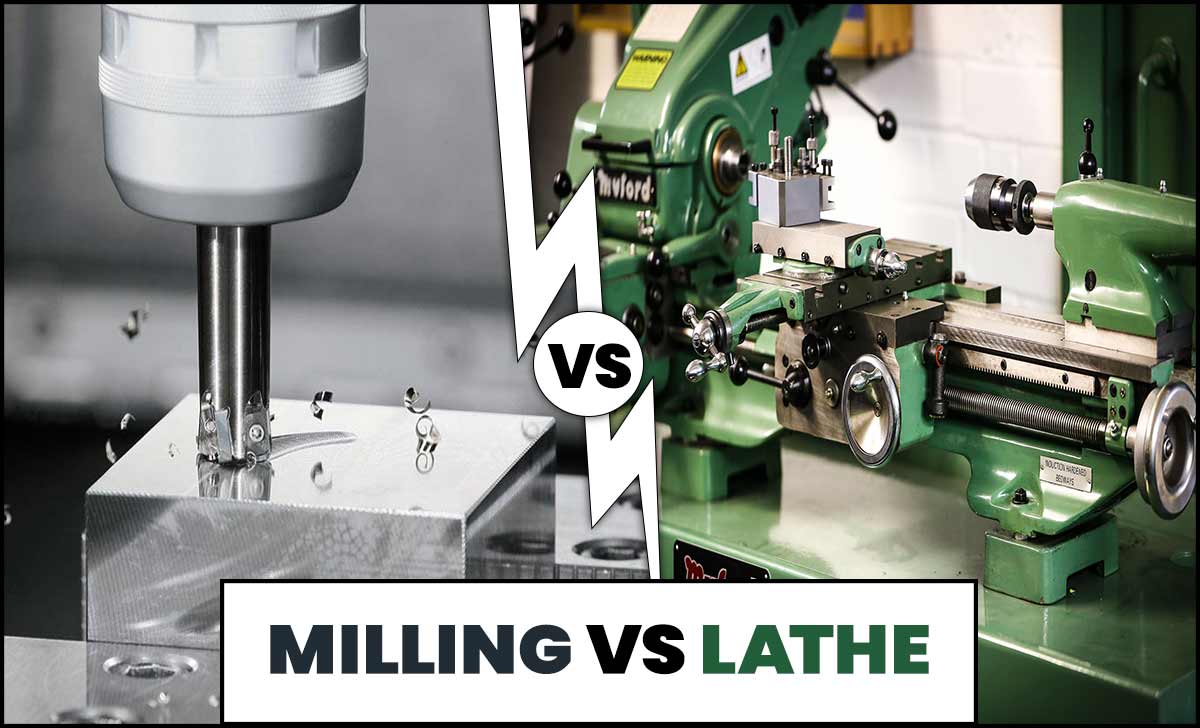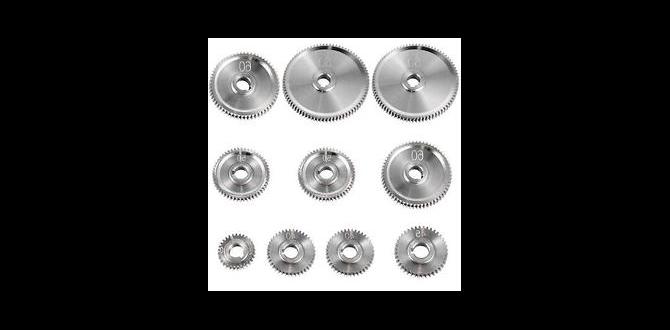For a perfect copper mirror finish with a 1/8-inch carbide end mill, proper tool selection, precise speeds and feeds, and consistent finishing passes are key. This guide breaks down the process for beginners, ensuring a beautiful, smooth result.
Welcome to Lathe Hub! Ever look at those smooth, almost gleaming metal surfaces on machined parts and wonder how they did it? Getting a beautiful, mirror-like finish on copper can seem tricky, especially when you’re just starting out. It’s like trying to get a perfect shave with a dull razor – frustrating and not very rewarding! The good news is that with the right approach and a few key techniques, achieving that “proven copper finish” is absolutely within your reach. We’ll walk through this step-by-step, making sure you feel confident and ready to tackle this project. Get ready to transform your copper projects!
Understanding Your 1/8-Inch Carbide End Mill for Copper
When we talk about getting a fantastic finish on materials like copper, the tool itself plays a starring role. A 1/8-inch carbide end mill is a precise instrument, and understanding its nuances is the first step to success.
Why Carbide for Copper?
Carbide, specifically tungsten carbide a href=”https://www.carbide.com/about-carbide/” target=”_blank”>carbide, is a super hard and wear-resistant material. This means it can hold a sharp edge much longer than high-speed steel (HSS) tools. For materials like copper, which can be a bit “gummy” and prone to sticking to tooling, the hardness and heat resistance of carbide are incredibly beneficial. It allows for faster cutting speeds and cleaner cuts without excessive heat buildup, which is crucial for a smooth finish.
The Importance of Flute Count and Geometry
Not all carbide end mills are created equal when it comes to finishing. For copper, you’ll typically want an end mill with:
Fewer Flutes: Two-flute end mills are often preferred for softer metals like copper. The extra space between the flutes (known as the chip gullet) helps to clear away the softer, more pliable copper chips easily. Too many flutes can cause chip packing, leading to a poor finish and potential tool breakage.
Polished or Bright Flutes: Look for end mills with highly polished or bright flutes. This smooth surface reduces friction and prevents copper from sticking to the tool.
Specific Coatings: While not always necessary for copper, some specialized coatings can further enhance chip evacuation and reduce friction. For a mirror finish, many machinists prefer uncoated or TiN (Titanium Nitride) coated end mills, as the smooth surface of the carbide itself is often sufficient.
Shank Diameter Matters: 1/8-Inch Shank for Precision
While the cutting diameter is 1/8 inch, you’ll often find these with a 1/4-inch shank for added rigidity in some tool holders. However, for extremely precise work or when working with very delicate setups, a full 1/8-inch shank end mill might be used, though these are less common and require very secure fixturing. For most beginners, a 1/8-inch cutting diameter with a 1/4-inch shank is a well-balanced choice for both precision and stability.
The “Proven Copper Finish” Explained
What exactly is a “proven copper finish”? It’s a surface finish that is exceptionally smooth, often approaching a mirror polish, where you can see a clear reflection. This isn’t just about removing material; it’s about refining the surface to a state of minimal roughness. For copper, this means:
Eliminating Tool Marks: No visible lines or chatter from the cutting tool.
Smoothness to the Touch: A silky, almost frictionless feel.
High Reflectivity: The ability to see a clear reflection in the surface, much like a mirror.
Achieving this on copper requires a combination of the right end mill, meticulous setup, and the correct machining parameters.
Essential Tools and Setup for a Flawless Finish
Before you even think about turning on the mill, let’s make sure you have everything ready. A good setup prevents headaches and ensures safety.
Your Milling Machine and Work Holding
Whether you’re using a dedicated CNC mill or a manual one, ensure it’s in good working order. For this operation, a rigid machine is essential.
Mill: A small vertical milling machine or a benchtop CNC mill is ideal.
Vise: A solid, precision milling vise is crucial for holding your copper workpiece securely. Ensure the vise jaws are clean and provide even clamping pressure.
Collet Chuck: Using a high-quality collet chuck is highly recommended for holding your 1/8-inch end mill. This provides the best concentricity (ensuring the tool runs perfectly true) and rigidity, which is vital for a good finish. Avoid using a drill chuck if possible, as they tend to be less precise.
Workpiece Material: Ensure your copper stock is clean, flat, and properly deburred. Surface irregularities on the stock can translate to poor finishes.
Your 1/8-Inch Carbide End Mill
As discussed, choose a 2-flute, polished carbide end mill. For a mirror finish, a specific type of geometry called a “ball end mill” or “radius end mill” can be very effective, as they have no sharp corner that can catch and mark the material. However, a square end mill can also work if used for the final finishing passes.
Cutting Fluid/Lubricant
Working with copper can generate heat and friction. A good cutting fluid or lubricant is not optional; it’s essential for a good finish and tool life.
Types of Lubricants:
Soluble Oils: Emulsify with water to create a milky coolant. Great for general machining and heat dissipation.
Synthetics: Water-based with no oil. Offer good cooling but less lubrication.
Neats Oils: Straight oils, offering excellent lubrication but less cooling.
Specialty Copper Lubricants: Some brands offer lubricants specifically formulated for copper, designed to reduce adhesion and improve surface finish.
Application: For a 1/8-inch end mill, misting or a flood coolant system is best. Hand application with a brush or spray can also work for small projects but requires more attention.
Measuring Tools
Calipers: For measuring your workpiece.
Dial Indicator: To check for runout in your spindle and collet.
Step-by-Step Guide to Achieving a Copper Mirror Finish
Now that you have your tools and setup ready, let’s get machining. This process involves multiple steps, from roughing out to the final delicate finishing passes.
Step 1: Prepare Your Workpiece and Machine
1. Clean the Copper: Ensure your copper stock is free of any dirt, oil, or oxidation. A quick wipe-down with a degreaser or solvent is a good start.
2. Secure the Workpiece: Mount your copper securely in the milling vise. Make sure it’s as flat and stable as possible. Use soft jaws if you’re concerned about marring the copper, especially near the finished surfaces.
3. Install the End Mill: Insert your 1/8-inch carbide end mill into your collet chuck. Ensure the collet is the correct size for the shank of your end mill. Mount the collet chuck securely in the milling machine spindle.
4. Check for Runout: Use a dial indicator to check for runout at the spindle. Ideally, it should be less than 0.001 inches. Then, check the runout of the end mill itself. Excessive runout will prevent a good finish.
Step 2: Determine Speeds and Feeds (The Magic Numbers!)
Getting the right speeds and feeds is critical. This is often the most challenging part for beginners, as it depends on many factors. However, there are good starting points for copper.
Surface Speed (SFM): For carbide on copper, a surface speed in the range of 300-600 SFM is a common starting point.
Spindle Speed (RPM): You can calculate this using the formula: RPM = (SFM 3.82) / Diameter (inches).
For a 1/8″ (0.125″) end mill: RPM = (300 to 600 3.82) / 0.125 = 9168 to 18336 RPM.
Important Note: Most hobbyist mills may not achieve such high RPMs. If your machine has a lower RPM limit, you’ll need to work within its capabilities and adjust feeds accordingly.
Feed Rate (IPM – Inches Per Minute): This determines how fast the tool moves through the material. A good starting point for a 2-flute carbide end mill in copper is around 0.001 – 0.003 inches per tooth (IPT).
Feed Rate (IPM) = IPT Number of Flutes RPM.
Using our calculated RPM (e.g., 10,000 RPM) and 0.002 IPT: Feed Rate = 0.002 2 10000 = 400 IPM.
Practical Adjustment: Again, your machine’s capabilities will dictate the maximum feasible feed rate. If your machine can’t G-code an extremely high feed rate, you’ll be moving the handwheel, which requires a feel for it.
Table 1: Recommended Starting Speeds and Feeds for 1/8″ Carbide End Mill on Copper
| Parameter | Value Range | Notes |
| :—————- | :——————– | :——————————————————————– |
| Surface Speed | 300 – 600 SFM | For carbide on copper. Higher SFM generally yields better finish. |
| Spindle Speed | 9,000 – 18,000 RPM | Depends on machine’s maximum RPM. Target the higher end if possible. |
| Chip Load (IPT)| 0.001 – 0.003″ | Inches per tooth. Start conservative and increase if chip looks good. |
| Feed Rate (IPM)| 200 – 600 IPM (approx)| Calculated based on RPM, flutes, and chip load. |
| Depth of Cut | 0.010″ – 0.050″ | Varies greatly. For finishing, very shallow. |
| Width of Cut | 0.050″ – 0.125″ | For finishing passes, usually a light radial engagement. |
A Note on High-Speed Machining: To achieve a true mirror finish, especially with a small 1/8-inch tool, higher spindle speeds are often beneficial. These speeds allow for a lighter chip load, which results in a smoother surface. If your machine is manually controlled, you’ll be using the handwheels to feed the tool. In this case, focus on smooth, consistent movements and a very light depth of cut.
Step 3: Roughing Passes (If Necessary)
If your part isn’t already close to the final dimensions, you’ll need to do some roughing first.
1. Plunge Feed Rate: When entering the material vertically (plunging), use a much slower feed rate than your side-milling feed rate – almost a drilling speed. A starting point could be 10-30% of your horizontal feed rate. For copper, you can plunge faster than with steel.
2. Axial Depth of Cut: For roughing, a depth of cut of 0.010″ to 0.050″ is usually appropriate for a 1/8″ end mill. Never try to take too much material at once, as this can overload the tool and create chatter.
3. Radial Width of Cut: For roughing, you might take a full or partial radial cut (engaging 50-100% of the tool’s diameter).
4. Coolant: Ensure your coolant is actively reaching the cutting zone.
Example Roughing Pass:
Depth: 0.030″
Feed Rate: 20-40 IPM (plunge), 100-200 IPM ( XY)
Spindle Speed: As high as your machine allows for optimal chip formation.
Step 4: Semi-Finishing Passes
After roughing, you’ll want to bring the part closer to its final dimensions.
1. Reduce Depth of Cut: Take a shallower axial depth of cut, perhaps 0.005″ to 0.020″.
2. Adjust Feed Rate: You can slightly increase your feed rate if the cutting is clean during roughing.
3. Aim Closer to Final Size: Leave about 0.005″ to 0.010″ of material for the final finishing pass.
Step 5: The Crucial Finishing Pass(es)
This is where the magic happens. The goal is to remove a very small amount of material with a very light cut to achieve that mirror finish.
1. Axial Depth of Cut: This should be extremely shallow. Start with 0.001″ to 0.003″. This is often called a “spring pass” or “clean-up pass.”
2. Radial Width of Cut: For a mirror finish on a vertical or horizontal surface, you’ll typically use a light radial engagement. For a round part being milled from the outside, you might take a stepped cut where each pass slightly overlaps the previous one. For side milling a flat surface, a light stepover (e.g., 0.020″ to 0.050″) is common.
3. Feed Rate: Maintain a consistent feed rate, similar to what worked well for semi-finishing, or slightly increase it if the cut is extremely light. The key is consistency.
4. Coolant: Keep the coolant flow steady.
5. Motion: Ensure your machine’s movement is smooth and free of backlash or vibration.
6. Multiple Passes: Sometimes, one finishing pass isn’t enough. You might need to take a second light pass, or “walk” the tool around the perimeter with a very small stepover and a very light depth of cut.
Table 2: Finishing Pass Parameters for a Copper Mirror Finish
| Parameter | Value | Notes |
| :—————- | :——————- | :———————————————————– |
| Axial Depth | 0.001″ – 0.003″ | Very light cut. Crucial for a smooth surface. |
| Radial Width | 0.020″ – 0.050″ | Light stepover/engagement. Ensures no tool marks are left. |
| Feed Rate | 200 – 500 IPM (or max)| Consistent and smooth feed. |
| Spindle Speed | Max RPM possible | Higher RPMs generally better for finish quality. |
| Coolant | Continuous flow | Prevents heat buildup and lubricates. |
External Link on Machining Parameters: For a deeper dive into understanding speeds and feeds, the National Institute of Standards and Technology (NIST) provides valuable resources, though they can be highly technical. For beginners, focusing on established charts and practical experience is often more approachable. You can explore general machining principles at NIST’s Advanced Manufacturing section.
Step 6: Post-Machining Cleanup and Inspection
1. Remove Tool: Once the finishing passes are complete, carefully retract the tool.
2. Clean the Workpiece: Gently clean the copper part. You can use a soft cloth or brushes.
3. Inspect the Finish: Examine the surface under good lighting. You should see a noticeable improvement in smoothness and reflectivity. If there are any subtle marks, a light hand-sanding with very fine grit sandpaper (e.g., 1000-2000 grit) or a polishing compound might be needed, but ideally, the machining should do the work.
Common Challenges and How to Overcome Them
Even with the best intentions, you might run into a few snags. Here’s how to deal with them:
Copper Sticking to the End Mill (Galling): This is copper’s nature.
Solution: Ensure adequate lubrication and coolant. Check your speeds and feeds – if you’re cutting too slow or too shallow, the copper might rub instead of cutting cleanly. Consider a slower spindle speed for roughing if your high-speed setup isn’t working. Ensure your coolant is fresh and effective.
Chatter or Vibration: This results in a rough, choppy surface finish.
Solution: Check for rigidity everywhere: secure workpiece, tight vise, rigid tooling setup (collet chuck is best), and a stiff mill. Reduce your depth of cut and try a faster feed rate (but within chip load limits). Ensure your end mill is sharp and not worn.
Tool Breakage: A 1/8″ end mill is delicate.
Solution: Never force the cut. Ensure proper speeds and feeds. Avoid side binding. Do not try to take too deep of a cut, especially on roughing passes. Make sure the mill is programmed to enter and exit the material smoothly.
Uneven Finish: Some areas are smooth, others aren’t.
Solution: This often points to inconsistencies in your machine’s movement (backlash), uneven lubrication, or inconsistent handwheel feeding. Ensure consistent tool








